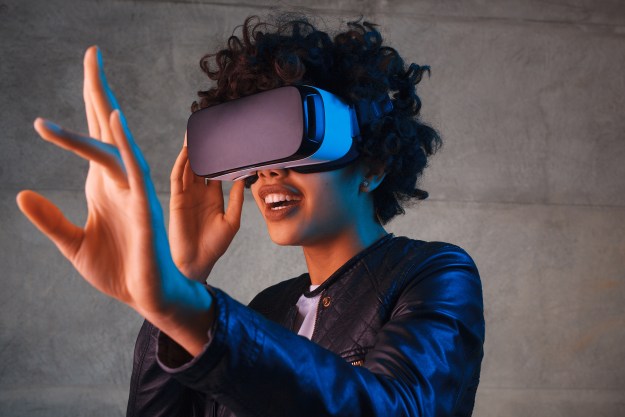Boring carpool got you down? Road trips with the family turning your hair prematurely gray? Holoride and HTC might have just the solution to make you look forward to your daily commute, and to turn unruly passengers into quiescent drooling zombies. They intend to bring VR to your car.
More specifically, the concept they’re pitching involves XR (Extended Reality), which includes a wider selection of sci-fi goggle-based content than just VR. The tech being debuted today takes advantage of the new HTC Vive Flow VR headset, which Digital Trends mobile editor Ajay Kumar got to test out last fall. This device differs from your garden-variety VR headset in that it’s more like wearing a big pair of sunglasses.
It’s quite expensive, and limited in some ways compared to other stand-alone and PC-connected headsets, but it solves the weight and bulk issues that have been a part of what’s held back mainstream VR popularity. Where other headsets are designed to stay at home, the Vive Flow is designed for life on the go.

HTC Vive Flow
It’s a very comfortable headset that might even be considered stylish if you’re into steampunk. Importantly, it also has a really nice 3.2K display with a 100-degree field of view and a 75Hz refresh rate, as well as 3D spatial audio. This makes it ideal for consuming movies and shows in a virtual theater environment.
HTC’s collaboration with Holoride is intended to integrate the Vive Flow with your car journey to create a more hyper-immersive experience. They will accomplish this by taking real-time motion, location, and navigational data from the vehicle and merging it into virtual experiences. It will also be possible to interact with these VR experiences using gestures as you would with a traditional VR device. There will also be a cinema mode where your two-dimensional video content will be synchronized to your motion in the car.
Made for car rides
One example of a use scenario for the Vive Flow while riding as a passenger in a car is as a virtual amusement park. Riding roller coasters has been a staple of VR demos since the first headsets hit the market, yet for all of their excitement, the lack of actual motion has rendered them a purely visual experience. However, by riding as a passenger in a car, you’d get that missing feeling of motion.
Now when zooming along a virtual roller coaster track, that track will mirror your movement in the car, so when you go around a corner on the road, you turn a corner on the roller coaster. Slow down and come to a stop at a light, and the roller coaster might go up to the top of a hill and pause before hurtling downward when the light turns green and the car accelerates.

When it comes to films, it’s easy to imagine how a lightweight VR headset could aid in watching them in a moving vehicle. For one, you would no longer have to rely on a cramped phone screen, and instead would have an experience much closer to a movie theater. What’s more, the same tech that turns your car into a roller coaster using your location and motion could also counteract the motion sickness that can result from watching a static screen in a moving vehicle.
As exciting as the potential of this technology is, there are also some challenges it will have to overcome. Most significant is the social aspect of sticking on a headset and shunning the driver’s company. While in some cases, the driver may not mind, and may even prefer such a lack of attentive company, it might also be somewhat awkward to be the lone person in a car full of passengers all tuned into a virtual world. It would be worse yet for the driver if passengers respond to that VR roller coaster the way some people do to actual roller coasters with screams, flailing hands, and upset stomachs.

However, to go back to a more positive angle on this tech, this could provide a definite boon to parents who want to distract their children and prevent the dreaded are-we-there-yet syndrome on long drives. Better yet, this headset would eliminate the irritation of movies and games playing out loud on seatback screens, tablets, or portable game consoles. VR in the car might well make the journey far more exciting than the destination.
A driverless future
Once truly driverless cars become commonplace, it’s not hard to envision a future where driving a dozen hours to an overcrowded National Park is replaced by VR adventures experienced in the convenience and safety of your own cul-de-sac. Just hop in, tell your car to circle the block, and go for a drive through Yellowstone, complete with close encounters with grizzlies and bison.
I will set aside such sci-fi speculation for the moment, however. Here in the present, though, the tech that Holoride and HTC have developed opens the door to intriguing possibilities in the realm of on-the-go entertainment.
Holoride’s XR technology is expected to launch sometime in the second half of 2022.
Editors' Recommendations
- The Apple Vision Pro has given VR its iPhone moment
- HTC’s new Vive VR Wrist Tracker tracks hands accurately — even when out of sight
- The future of immersive VR? ‘Chemical haptics’ applied to your skin
- We have some bad news about Apple’s rumored VR headset
- HTC Vive Flow hands-on: A weird, compact VR headset for meditation and wellness





